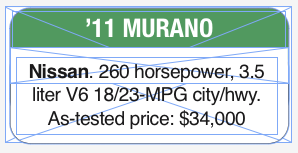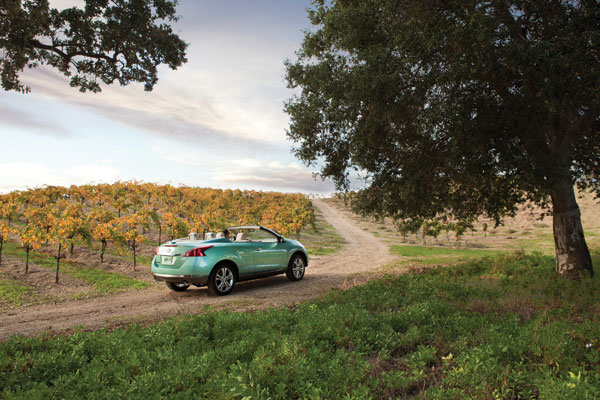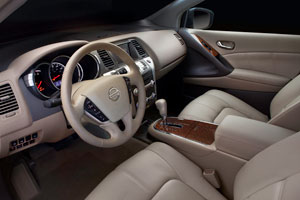Nissan tinkered with near-perfection for its Murano redo, but the sleeker, high-powered sedan somehow seems less special
CASEY WILLIAMS | Auto Reviewer
crwauto@aol.com
I was a big fan of the first-generation Nissan Murano when it debuted eight years ago. Styling inside and out looked like it rolled out of a design studio, took a quick pass through a show of concept cars and bee-lined for the Interstate. I drove one from Atlanta to Memphis one afternoon and fell in love with its comfy seats, aluminum trim panels, cool gauges and symphonic Bose audio system. The dashboard looked like an infinity pool as it dropped off towards the windshield. Even my grandmother loved it.
Sadly, the original is no more and we now are confronted with the re-designed gen-II edition. I miss the old one already.
Most people will probably like the current generation’s styling better. It is edgier, more detailed and a tastier feast. Murano’s beak is its most distinguishing feature, along with a chrome grille that pinches towards the bumper and appears to rest on top of the wide piercing high-intensity discharge headlamps. A wide, sculpted hood flows smoothly from grille to windshield and attaches to an arched roofline that looks more like that of a sport sedan than wagon.
Standard 18-in. (or optional 20-in.) alloy wheels look great under the precision body and accentuate the vehicle’s aggressive attitude. The rear flaunts curved glass, roof spoiler, dual chrome exhausts and large LED taillamps that were revised for 2011.
Infiniti drivers should recognize much of the interior; up-level models have woodgrain on the center console. But I crave the aluminum panels on sportier models. A large LCD screen is controlled with buttons on the dash top while climate and audio have buttons and knobs in their typical location in the console. Big analog gauges are easily read through the leather-wrapped steering wheel. Seats look great in leather, less so in our cloth-clad test model. Rear passengers have plenty of space, even when seated behind tall drivers. I still don’t like the interior as well as the old Murano’s, but who asked me anyway? It’s nice, but somehow feels less special.
Beyond looking dapper, the Murano came loaded with goodies. USB ports, Bluetooth and in-dash CD player keep everybody connected and entertained. Navigation is optional, as are top-rate audio systems if you check the right boxes on the options sheet. Automatic climate control and auto up/down windows add convenience.
Whatever somebody thinks of the Murano, they will not likely criticize its powertrain. All versions are motivated by a 260-horsepower, 3.5-liter DOHC V6 engine connected to a continuously variable transmission (CVT). CVTs can sometimes make a car drive like a high-powered golf cart, as the transmission whirs away devilishly under the floor. Not this one: It was so quiet and smooth that it took several miles before I realized it wasn’t a regular automatic. AWD is available, but our test vehicle came in front-drive, allowing it to achieve 18/23-MPG city/highway. I clocked 21.5 MPG in mixed driving.
You won’t run to the Murano to solve your fuel economy woes — there are full-size SUVs that do better. But none of those giants are likely to handle as well as the sedan-based Murano. Based on the Altima/Maxima vehicle architecture, the original Murano put Nissan in the crossover game. It rode and drove like a Maxima wagon because that’s essentially what it was.
 The same is true of the 2011 model for the same reason — it shares a ton of engineering with its sedan siblings. There’s a four-wheel independent suspension system, four-wheel ABS disc brakes, vehicle dynamic control (VDC) and traction control — all basically the same as an Altima’s.
The same is true of the 2011 model for the same reason — it shares a ton of engineering with its sedan siblings. There’s a four-wheel independent suspension system, four-wheel ABS disc brakes, vehicle dynamic control (VDC) and traction control — all basically the same as an Altima’s.
There are a couple of things I don’t exactly love about the Murano. Our test vehicle came with a cloth interior harboring seats that felt like fur-covered blocks of foam. They were comfy enough, but didn’t quite rise to the vehicle’s price. Numb steering gives little feedback on the vehicle’s behavior. You drive a Murano with your eyes, not your fingertips or butt. For the enthusiasts among us, that’s not so much fun.
Apparently Nissan/Renault CEO Carlos Ghosn wasn’t satisfied with a deftly styled yet conventional five-passenger crossover. Nope: His mind conjured off the top while replacing four doors with two. What at first seems a little nutty is actually a roomy convertible loaded to the gunnels with rich leather, next-century style, and all of the intuitive controls that come in less breezy Muranos. A power cloth top with integral skylight over the rear seats is a nice touch.
After four hours on the Interstate, using the cargo hold for actual cargo, and enough city traffic to choke a horse, I warmed up to the Murano. I’m a big fan of its style — even if it doesn’t have the concept car feel of the original.
Our car retailed for $34,000, making it competitive with the Toyota Venza, Ford Edge, Chevy Equinox and Honda Crosstour.

















